Our fraction worksheets are the best on the internet! These free worksheets are perfect for students of all ages who are learning or reviewing fractions. Our fraction worksheets cover a range of skills, from simplifying fractions to adding and subtracting fractions with different denominators. Each worksheet includes clear instructions and plenty of space for students to show their work. With our fraction worksheets, you'll find everything you need to help your students master this important math concept. So why wait? Try our fraction worksheets today and see why they're the best on the internet!
Browse Sheets By Problem Type
×
Introduction to Fractions
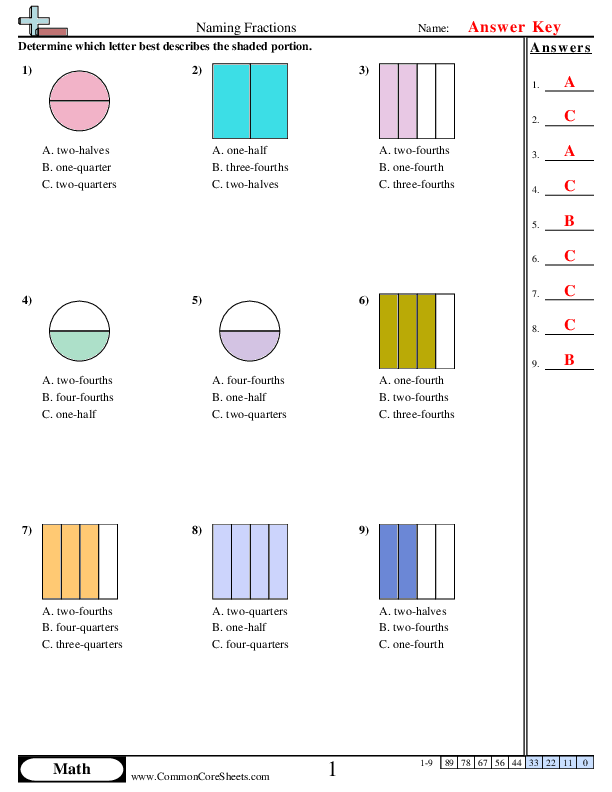
Naming Fractions
1g3


×
Description:
"This worksheet is designed to enhance understanding of naming fractions in mathematics for children. It includes 9 problems, presenting three fraction options and testing identification skills. From one-quarter to four-quarters, children learn to distinguish different fractions. The worksheet is versatile – easily customizable, convertible into flash cards, or utilized in distance learning environments, making it a useful tool for both home and classroom education."

×
Student Goals:
Improve Numeracy SkillsUpon completion of the 'Naming Fractions' worksheet, students should be able to demonstrate improved numeracy skills. They will have developed a better understanding of various fractions and their names, a foundational skill in mathematics learning.Identification of FractionsStudents will be able to identify different fractions confidently. They'll be able to understand and differentiate between one half, one quarter, three quarters, and other fractions. Their ability to recognize these fractions by name will be enhanced.Understanding Fraction ConceptsThe completion of the worksheet will provide students with a more grounded comprehension of fraction concepts. They will be well equipped to understand fractions as parts of a whole, enhancing their critical thinking abilities in mathematical problems.Boosting Problem-Solving AbilitiesBy working through the 'Naming Fractions' worksheet, students will have practiced and developed their problem-solving abilities. This process ensures they can apply their knowledge of fractions to resolve similar problems successfully.Building ConfidenceSuccessfully completing the worksheet will build the students' confidence in dealing with mathematical problems involving fractions. It will also foster a positive attitude towards math as they witness their own growth and development.Preparation for More Complex ProblemsThis worksheet will prepare students to tackle more complex mathematical problems. Understanding the names and values of common fractions is an important stepping stone towards dealing with more complicated fraction problems and equations, positioning them well for future learning.Acquiring Consistency & SpeedSolving similar types of problems repeatedly through the 'Naming Fractions' worksheet will not only bring consistency in recognizing and naming the fractions swiftly, but it will also help students to increase their speed in solving such problems.


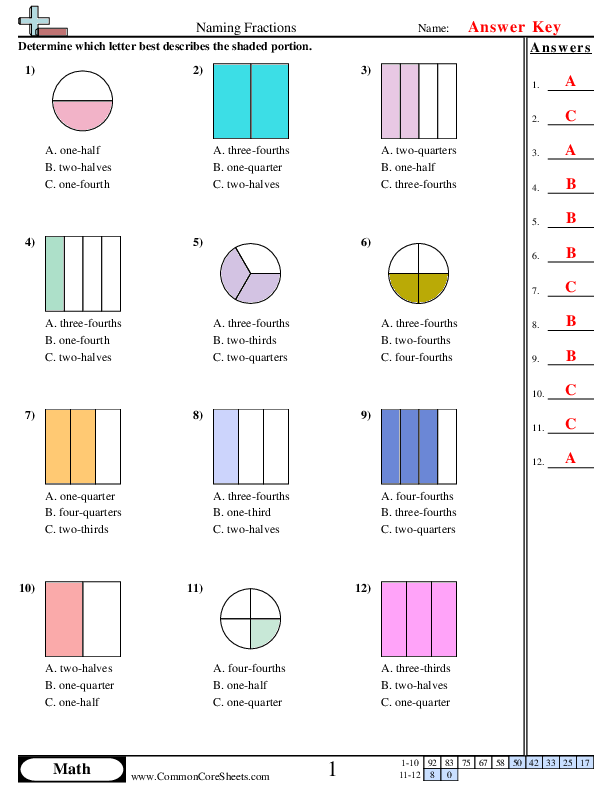
Naming Fractions
2g3


×
Description:
"This worksheet is designed to enhance children's understanding of fractions. Each of the 12 math problems prompts them to correctly name different fractions, reinforcing the concept. The worksheet is versatile as it can be tailored to each individual learner, converted into flashcards, or integrated into distance learning programs, making it a valuable tool for both teachers and students alike."

×
Student Goals:
Understanding Fraction BasicsUpon completion of this worksheet, students will gain a solid foundation in understanding the basics of fractions. They will be able to name frequently used fractions in their simplest form as well as in other equivalent forms. Fractions including halves, thirds, and quarters will be familiar terms for them, therefore, paving the way for more complex fraction problems.Ability to Identify Equivalent FractionsChildren will acquire the ability to identify equivalent fractions, a critical component in the broader world of fractions. They would be able to recognize that two halves are equivalent to one whole or four quarters, thus establishing core knowledge that will help in the understanding of fraction simplification in future lessons.Boosting Critical ThinkingIn addition, the worksheet will serve as a tool for sharpening the pupils' critical thinking skills. They will be required to apply logic in determining the correct answers, a skill that extends beyond math, and is applicable to several other academic disciplines and life situations. This thereby nurtures a generation of thorough thinkers capable of making logical decisions.Confidence With FractionsAfter working through this worksheet, students should feel a gain in confidence in dealing with fractions. The understanding that they will develop from this exercise will eliminate any feeling of intimidation that fractions might have precipitated initially. This confidence is essential in propelling their interest in further math-related activities, as a strong mathematical foundation can be pivotal to success in various professional fields.Preparation For Advanced MathematicsLastly, the knowledge and skills garnered from this worksheet will put students on sure footing for more advanced math topics. They will be better prepared to tackle complex tasks involving fractions such as adding, subtracting, multiplying, and dividing fractions. Essentially, this worksheet serves as an important steppingstone on their math learning journey.



Writing Fractions
3nf1


×
Description:
"This worksheet is designed to strengthen children's understanding of writing fractions. It contains 18 problems focusing on various aspects of the subject matter, creating an interactive and engaging learning experience in math. The worksheet is customizable, perfect for transforming into flash cards, and aligns seamlessly with distance learning needs. This resource simplifies the concept of fractions, making learning mathematics an enjoyable and productive process."

×
Student Goals:
Understand Basic Concepts of FractionsUpon completion of this worksheet, students should have a solid understanding of the basic concepts of fractions. They should be able to identify the numerator and denominator of a fraction and understand what these components represent. This foundational knowledge of fractions is integral to further mathematical learning and can be applied to more advanced concepts such as ratio and proportion.Perform Basic Fraction OperationsStudents should also be able to perform basic operations with fractions such as addition, subtraction, multiplication, and division. They should understand when these operations are applicable and how to execute them correctly. This acquired capability will enable students to solve an array of mathematical problems using fractions, contributing to their overall math proficiency.Simplify FractionsAnother accomplishment students should gain from completing the worksheet is the ability to simplify fractions. This means students will know how to identify and create equivalent fractions, a crucial skill that simplifies calculation and aids in comprehending more complex mathematical relations involving fractions. With this skill, fractions can be manipulated with increased efficiency, thus eliminating unnecessary complexities.Use Fractions in Practical SituationsBeing able to apply fractions to practical situations is another accomplishment students should achieve. This means using fraction-based problems to represent and solve real-world scenarios. This practical application will not only further students' understanding of fractions in a tangible context but also cultivate a connection between their mathematical learning and daily life.Display Kindergarten ReadinessLastly, completion of this worksheet should assist the student in exhibiting readiness for next-level mathematics. This means progressing towards being adequately equipped with the knowledge and skills necessary to tackle more complicated fraction-related problems as they advance in their academic journey. With this accomplished, students will be prepared to face challenges with confidence and competence.


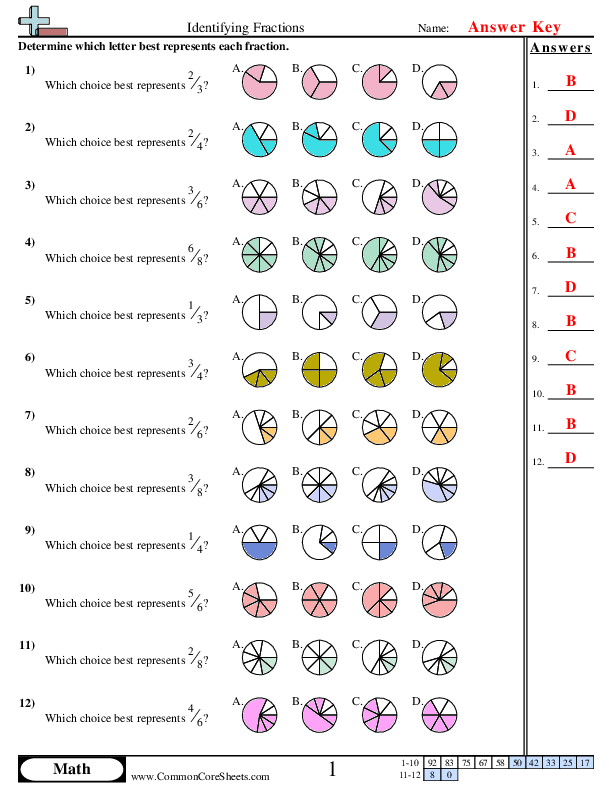
Identifying Fractions
3nf1


×
Description:
"This worksheet is designed to help children identify fractions through a series of 12 math problems. The interactive format allows the child to choose from multiple answers, enhancing understanding of the concept. Adaptable for diverse learning formats, the worksheet can be customized, converted into flash cards, or utilized in a distance learning environment for an engaging study experience."

×
Student Goals:
Understanding of FractionsBy the end of this worksheet, students should have a clear understanding of basic fractions. They will be able to correctly identify various fractions when presented with visual or numerical options. This understanding forms the foundation for more complex operations with fractions.Mathematical ConfidenceStudents should gain confidence in their mathematical abilities, particularly in dealing with fractions. A solid grip on the concept of fractions plays a major role in many mathematical calculations involved in everyday life. Having this confidence early on would augur well for their overall mathematical ability.Problem-Solving SkillsThe completion of this worksheet helps improve students' problem-solving skills. While the focus is on fractions, the skills acquired can translate to other aspects of problem-solving. This ability to choose the correct answer from multiple options aids in the development of critical thinking.Visual InterpretationStudents should also enhance their visual interpretation skills. The ability to visually represent fractions is a skill on its own, beyond just mathematical ability. It serves as a bridge between the abstract idea of fractions and their more concrete representations.Application SkillsAfter successfully finishing this worksheet, learners should be able to apply their acquired skills in real-life scenarios. Recognizing fractions is an advantage in everyday scenarios, like reading a clock, dividing resources, identifying car speeds on road signs, etc. This direct application of academic learning to life skills is an essential factor that education aims to achieve.Preparation for Advanced TopicsUnderstanding fractions is just the tip of the iceberg. Once students have a grasp of this concept, they are more prepared to tackle advanced mathematical topics such as decimal points, percentages, ratio and proportion, etc. This worksheet serves as a stepping stone to these more advanced topics, thereby enriching students' mathematical journey.



Partitioning Shapes
3g2


×
Description:
"This worksheet is designed to enhance children's understanding of shape partitioning in math. The 9-problem set involves dividing different shapes into 2, 3, 4, 6, or 8 equal parts, reinforcing the concept of fractions. Customizable for diverse learning needs, the worksheet can also be converted into flashcards or utilized in distance learning environments to support flexible, interactive education."

×
Student Goals:
Understanding of Mathematical PartitioningUpon completion of the worksheet, students can gain a comprehensive understanding of mathematical partitioning. They should be capable of dividing shapes into equal pieces, showcasing an understanding of fair sharing and equal distribution - fundamental mathematical concepts. Students also learn to identify fractions as they label each part of the divided shape, therein making the connection between partitioned shapes and their numerical representation in fractions.Recognition and Comparison of FractionsThe skills acquired from this worksheet extend to the recognition and comparison of fractions. With varying problems that require splitting shapes into different quantity of parts - such as halves, thirds, quarters, sixths, and eighths - students will become adept at identifying these common fractions. In comparing these fractions visually, they may also begin to intuitively understand the core concept that different fractions can represent the same proportional quantity, riding the leap from concrete to abstract thinking in mathematics.Development of Fine Motor SkillsCompleting this worksheet also aids in the development of students' fine motor skills. Through drawing and partitioning shapes, students will showcase and enhance not only their mathematical understanding, but also their control, precision, and coordination in a fun and engaging way. This in turn, plays a pivotal role in the improvement of handwriting skills, dexterity, and speed in tasks that involve the hands.Problem Solving and Logical ReasoningAnother key accomplishment from this worksheet involves problem solving and logical reasoning. It promotes students to think critically on how to divide each shape evenly and use logical reasoning to ensure that each section represents the correct fractional part. This helps improve their capacity for strategic planning, and analytical thinking, creating a robust foundation for other areas of learning.Confidence in Mathematical MasteryLast but certainly not least, students upon completing the worksheet should experience a significant boost in mathematical confidence and self-efficacy. By successfully partitioning shapes and mapping them to the correct fractions, students gain tangible proof of their mathematical prowess and progress, thereby motivating them to tackle more complex mathematical concepts. The sense of accomplishment from completing the worksheet can thus serve as a powerful intrinsic motivator in their continued mathematical journey.


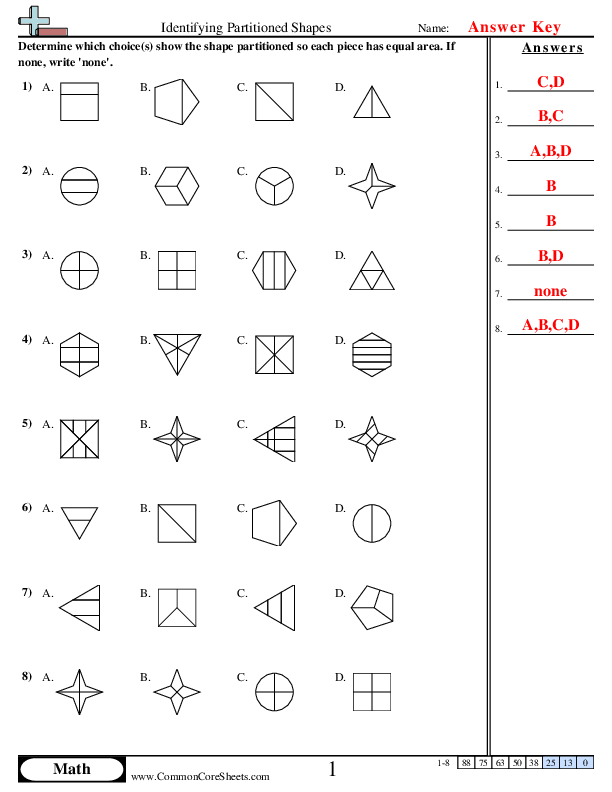
Identifying Partitioned Shapes
3g2


×
Description:
"This worksheet is designed to enhance children's understanding of partitioned shapes in mathematics. It comprises 8 interactive problems, promoting active learning in recognizing and differentiating various segmented shapes. Utilized as customizable flash cards, it serves as a fun and engaging tool for both classroom and distance learning. This versatile worksheet offers a dynamic approach to math education, fostering improved comprehension and retention.".

×
Student Goals:
Shape IdentificationAfter completing this worksheet, students should be able to identify a variety of partitioned shapes with increased accuracy and confidence. This process will help boost their geometric awareness and visual discrimination skills.Spatial UnderstandingBy working through spatially-oriented problems, students improve their ability to perceive and understand the spatial relationships among shapes. This skill is foundational in many areas, including higher mathematics, engineering and day-to-day spatial tasks.Critical ThinkingThis worksheet provides an opportunity for students to enhance their critical thinking skills. They will need to apply logic and reason, deducing the nature of the different partitioned shapes presented to them. Over time, this practice can lead to improved problem-solving abilities.Memory RecallStudents will exercise their recall skills in this worksheet. By identifying partitioned shapes that they've studied before, they strengthen their memory recall capabilities, which are essential in many learning environments and real-life scenarios.Pattern RecognitionThis exercise also promotes pattern recognition, a critical skill in mathematics and sciences. Recognizing patterns in shapes or sequences helps child to predict and understand natural and mathematical phenomena.Perseverance & ResilienceIn striving to solve the problems on this worksheet, students learn the importance of perseverance and building resilience. They are likely to encounter difficulties along the way, but these challenges will serve to motivate them to press on, thereby fostering a growth mindset.Application of KnowledgeCompleting this worksheet enables students to put into practice the knowledge they have learned in class. By actively engaging with the lesson content in a practical manner, they are more likely to internalize and retain the concepts and principles taught, leading to a deeper understanding of the subject matter.Mathematics AppreciationIn identifying and categorizing different partitioned shapes, students are exposed to the beauty and diversity of geometrical figures and the world of mathematics. This could potentially spur their interest and positively influence their attitude towards the subject.


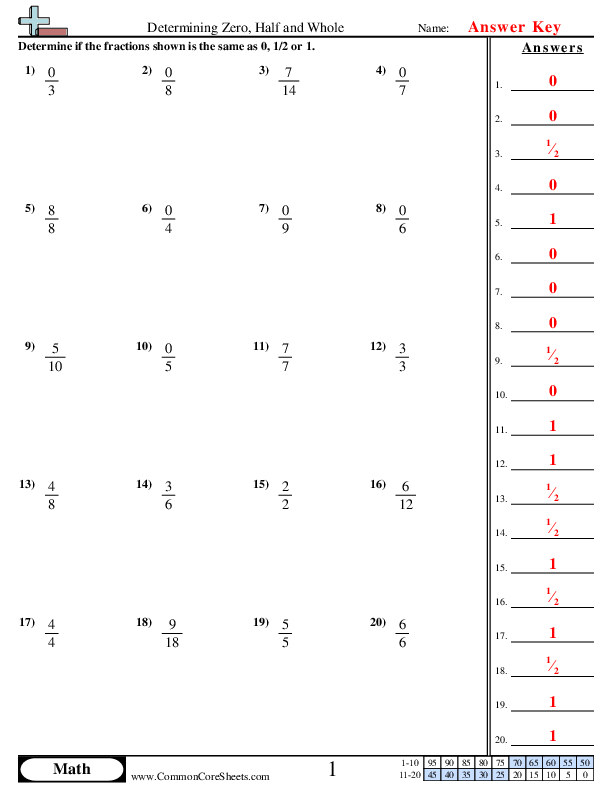
Determining Zero, half and Whole with Fractions
3nf3d


×
Description:
"This worksheet is designed to help children grasp the concept of zero, half, and whole numbers in mathematics. With 20 customizable problems, it conveys understanding via visual fraction representations. Perfect for online or distance learning, the worksheet can also be converted into flashcards for a hands-on learning experience. Engaging for all learners, it makes mastering this essential math skill both accessible and enjoyable."

×
Student Goals:
Understanding of Fundamental ConceptsStudents completing this worksheet should have gained a solid understanding of fundamental mathematical concepts, specifically those related to fractions. With a focus on halves, wholes, and zeros, students will have a deeper comprehension of how these different components function within the broader context of mathematical operations.Problem Solving AbilitySuccessfully finishing this worksheet suggests students are able to approach and solve problems effectively. These math-based exercises will have required high level of logical thinking, precision, and a strategic approach to problem-solving. Completion of this task will have helped to develop these skills, fostering confidence and competency in not just mathematics, but also in a myriad of other areas that require problem-solving ability.Fraction ComprehensionThe worksheet ensures students are adept at evaluating and understanding the idea of a 'half' and 'whole' when dealing with numbers. The skills to determine and differentiate zeroes, halves and whole numbers from a given set, will aid them in further algebraic calculations and mathematical tasks involving fractions and rational numbers.Numerical FluencyAs students complete the worksheet, they'll enhance their numerical fluency, gaining the ability to swiftly and accurately go through numerical information and interpret it. This proficiency is fundamental in both, day-to-day life and academic studies, developing the student's overall mathematical competence.Critical Thinking and Analytical SkillsCompletion of this worksheet will also manifest students' abilities to critically analyze and comprehend mathematical problems, applying learned concepts to evaluate and solve them. Such skills will improve their analytical thinking in a way that is translatable not only in math, but also in various other academic and real-world scenarios.Preparation for Advanced MathematicsThe understanding of basic fractions and numbers achieved from this worksheet will lay a solid groundwork for students as they advance to higher mathematical concepts. It will provide them with the necessary confidence and knowledge to tackle complex mathematical theories and problems in the future.



Examining Fraction Value
5nf3


×
Description:
"This worksheet is designed to enhance children's understanding of fraction values in math. It contains 20 problems involving the identification and interpretation of fractions. Examples include deciphering fraction values like 37/6, 84/9, and 76/7. The worksheet is customizable, can be converted into flashcards for effective learning, and is suitable for distance education, facilitating flexible learning environments."

×
Student Goals:
Understanding of FractionsUpon completion of this math worksheet, students will have developed a deeper understanding of fractions. They will have enhanced their knowledge on fraction values, and what these values signify in mathematical terms. They will comprehend how fractions represent part of a whole, and their use in different mathematical contexts.Critical Thinking and Problem-Solving SkillsStudents will have nurtured their critical thinking skills and problem-solving prowess. Converting fractions into simpler formats and comparing fraction sizes presents a good challenge to the young minds which aids in the development of these skills. Identifying patterns and deducing the easiest methods to solve these problems are valuable skills that will take them far beyond this specific math worksheet.Enhanced Numeracy SkillsThis worksheet will significantly beef up students' numeracy skills. By working through the problems dealing with fractions, students will establish and enhance their numerical literacy, important for their overall mathematical competency. This worksheet is designed to help them comprehend the foundational components of fractions and how to manipulate them mathematically.Acquisition of Practical SkillsWith this worksheet, students will acquire practical skills that will be used in their everyday lives. Understanding how to evaluate and use fractions is a vital element of practical routines such as cooking, financial planning, technical measurements and more. The understanding of this basic mathematic concept will prepare the students for these real-life mathematic applications.Improved Confidence in MathLastly, upon finishing the worksheet, students should have grown in their confidence in tackling math problems. Mastering each math unit injects confidence into students, making them more comfortable and less intimidated with numbers. Thus, they will be inclined to explore more complex mathematical concepts, fostering a habit of curiosity and lifelong learning.



Comparing Fractions Relative Size


×
Description:
"This worksheet is designed to enhance children's understanding of comparing fractions and their relative sizes. It includes fifteen practical math problems, asking students to discern differences in part-to-whole relationships. Examples involve everyday scenarios like comparing a fullness of dump trucks or water in swimming pools. Flexible and adaptable, this worksheet can be customized or transformed into flashcards, making it ideal for distance learning. It's a versatile tool to make math easily relatable and enjoyable for children."

×
Student Goals:
Understanding of FractionsStudents will gain a strong understanding of fractions and conceptually visualize the relative sizes of fractions. They will be able to identify which fractions are larger or smaller and apply these concepts in the context of relevant real life scenarios, fostering their reasoning skills.Application of Math in Real LifeThe learners will establish the practical significance of fractions by connecting them to everyday situations like time spent, distance covered, and quantities compared. They will perceive the vast application of the learned skills beyond the educational context, boosting their interest in mathematics.Enhanced Problem-Solving AbilitiesStudents will develop and boost their problem-solving skills by comparing fractions in various situations and conditions. They will independently evaluate given scenarios, process information, and draw logical conclusions. The practice would enable them to make appropriate mathematical judgments and decisions.Comparison and Relation of QuantitiesUpon completion of this worksheet, students will have improved their ability to compare and relate different quantities using fractions. This understanding will extend to interpreting how changes in one quantity can impact another and the consequences thereof, which is a key component in analytical thinking.Better Numerical FluencyLearners will demonstrate an improved capability to work with fractions, reinforcing their numerical fluency. By constantly interpreting, manipulating, and comparing fractions, students will enhance their mental arithmetic and detail-orientation, contributing to their overall mathematical adeptness.Deepens Critical ThinkingThe task exposed students to the realm of critical thinking. The process of interpreting numbers, relating fractions, and making comparisons enhances their cognitive skills. Over time, they will implicitly hone their ability to analyze, evaluate, and form judgements based on the problems they try to solve.Understanding Unit ConversionThrough these problems, students will understand the importance and relevance of correct unit conversion. Distinctions between different units of measure, such as grams versus kilograms, play a crucial role in the exercises. It will improve their ability to convert units and grasp the variations in scales and measurements.


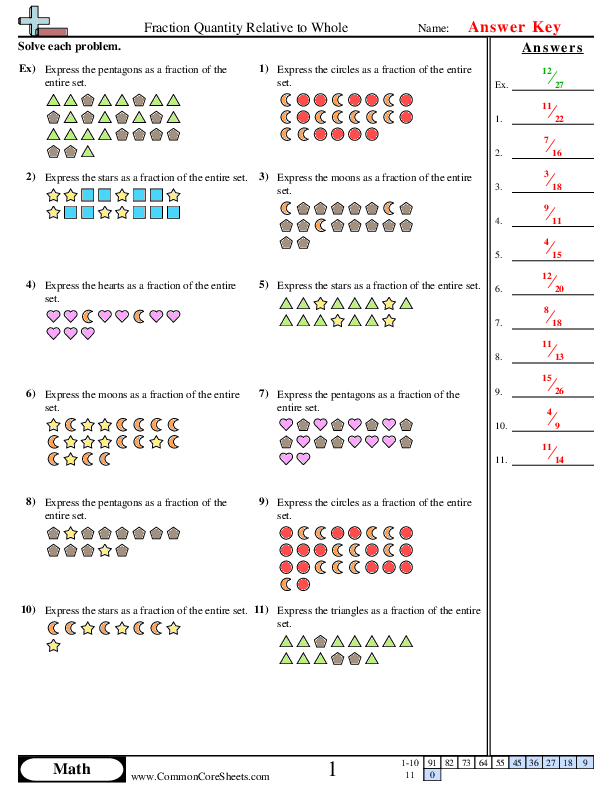
Fraction of Whole Visual


×
Description:
"This worksheet is designed to boost children's understanding of math, specifically fractions and their representation of whole numbers. It contains 11 problems which involve expressing various shapes such as squares, circles, triangles, stars, and hearts as fractions of an entire set. This worksheet's versatile format allows for customization and can be converted into flashcards, making it a valuable resource for distance learning."

×
Student Goals:
Understanding FractionsUpon completion of the worksheet, students should have a solid grasp of fractions. They should understand that a fraction represents a part of a whole. Students should be able to identify a fraction as a number on the number line and represent fractions visually. They should be able to distinguish and express parts of a whole as fractions, further developing their number sense and foundational math skills.Analyzing ShapesIn conjunction with understanding of fractions, students should also improve their geometric skills. By identifying and analysing different shapes such as circles, pentagons, stars, hearts, and moons in the problems, students reinforce their knowledge of basic shapes while strengthening their analytical and problem-solving abilities.Fraction ComputationsStudents will be equipped with the skills needed to perform calculations using fractions including addition, subtraction, comparison and equivalence of fractions. They will understand the relationship between numerators and denominators, and will know how to express one quantity as a fraction of another quantity. This knowledge will be fundamental for their further studies in mathematics.Critical Thinking SkillsCompleting the worksheet boosts students' critical thinking skills. Each problem requires students to apply knowledge of fractions and geometric shapes to a real-world context. This promotes analytical thinking and problem-solving skills, preparing students not only for more complex mathematics but also for decision-making processes in everyday life.Confidence in MathLastly, successfully completing the worksheet will breed confidence in the students' mathematical abilities. As they work through the problems and see their ability to solve them correctly, they will become more comfortable with fractions and math in general. The feeling of accomplishment they get after correctly completing this worksheet will motivate them to take on more challenging math problems in the future.



Finding Reciprocals


×
Description:
"This worksheet is designed to help children grasp the concept of finding reciprocals in math. With a total of 19 problems, it utilizes interactive content, such as fraction tables, to present examples and ensure understanding. The worksheet is customizable for diverse learning needs, can be transformed into flashcards for easy revision, and is perfectly suited for use in distance learning contexts."

×
Student Goals:
Understand the Concept of ReciprocalsAfter completing this worksheet, students should be able to grasp the concept of reciprocals, understanding that a reciprocal of a number is one divided by that number. This foundational knowledge will equip them to handle advanced mathematical problems in the future.Apply Reciprocal Concepts PracticallyThe worksheet will teach students how to practically find and apply reciprocals. They will learn how to find the reciprocal of a whole number and a fraction, and also apply it by confirming that the product of a number and its reciprocal equals one. This will foster their problem-solving skills.Improve Mental Math SkillsBy routinely finding reciprocals, students will sharpen their mental math skills. Students will develop a quicker and more accurate mental calculation ability, as reciprocals demand the understanding and application of division and multiplication concepts. This skill will be beneficial beyond the math classroom.Develop Logical ReasoningThe process of solving reciprocal problems involves logical reasoning. Consequently, students who can work through these problems are honing their logical reasoning abilities. This improvement can contribute significantly to their overall cognitive development and academic success in different subjects that involve logical thinking.Build Confidence in MathematicsThis worksheet will play a crucial role in building students' overall confidence in mathematics. By successfully finding reciprocals and understanding the logic behind them, students will feel more confident and enthusiastic about tackling more challenging concepts in mathematics. This increased confidence will likely improve their general performance in the subject.Prepare for Advanced Mathematical ConceptsUnderstanding reciprocals is essential in various advanced mathematical concepts such as algebra, calculus, and complex number theory among others. Therefore, completing these reciprocal problems will prepare students for more advanced studies in their future academic endeavors. It equips the students with a strong mathematical foundation for higher learning.



Adding to 1 whole


×
Description:
"This worksheet is designed to enhance children's understanding of adding fractions to make a whole. It offers 20 interactive problems that involve filling in missing parts to total one, leveraging both proper fractions and mixed numbers. The problems can be adapted to varying skill levels, offering a customizable resource perfect for in-person instruction or distance learning. Furthermore, the problems can easily be converted into flash cards for additional practice."

×
Student Goals:
Develop Mathematical SkillsUpon completing this worksheet, students should have made substantial progress in developing their fundamental math skills. This step towards perfection is crucial, particularly in addition that forms the basis for more complex mathematical concepts. Students will be comfortable dealing with numbers and have a deeper understanding of the concept of 'one whole' in mathematics, thereby building a strong foundation in the subject.Boost Problem Solving AbilitySuccessfully tackling all problems on the worksheet tasks students with learning to quickly identify patterns, employ logical reasoning, and find solutions. This cultivates a superior problem-solving approach in students, to be applied not just in math, but in various areas of life and study. The acquired skills encourage the ability to autonomously tackle new problems with increased confidence and precision.Understanding FractionsBy completing the exercises presented in the worksheet, students will have significantly improved their understanding of fractions. They will be able to add fractions to make up one whole, even when fraction denominators are different, a key skill in elementary math education. This paves the pathway for grasping more complex concepts like multiplication and division of fractions, ratio, and proportion in the future.Knowledge ApplicationUpon completion, students should be competent in properly applying their newfound knowledge to real-world scenarios. Be it telling time, cooking, or other practical situations where fractions play a huge role, they should be able to confidently use their skills to make calculations. This infuses math learning with more significance and relevance by appreciating its everyday application.Enhance Logical ThinkingSolving the problems in this worksheet helps in refining cognitive abilities, boosting logical thinking and promoting careful calculation in students. As they navigate through the varying complexities of each problem, they will learn to break down tasks into smaller, manageable parts, thereby building upon their strategic thinking abilities.Increase ConfidenceFinally, after acing all the problems in this worksheet, the students should be able to approach mathematical challenges with increased self-assurance. This sense of achievement promotes a positive learning environment, encourages further learning, and sets them up for future academic success. It helps them believe in their ability to handle more challenging problems ahead.


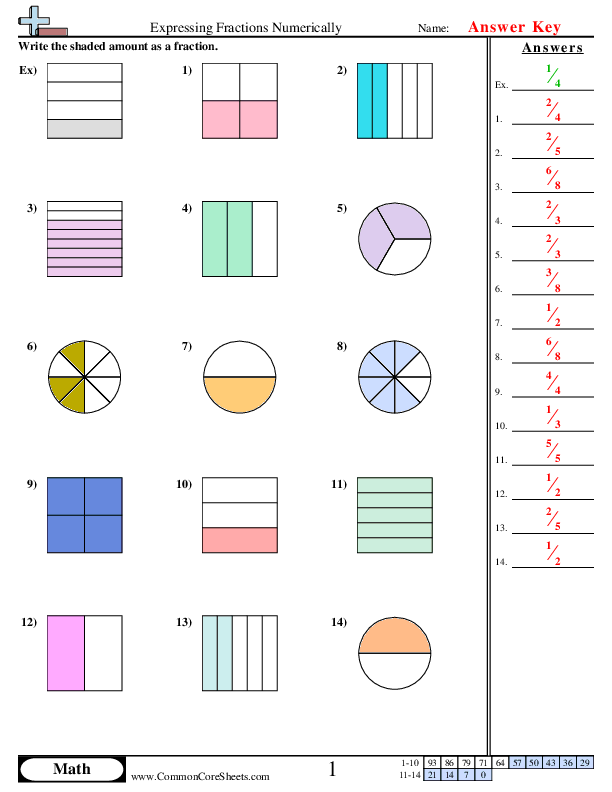
Expressing Fractions Numerically


×
Description:
This worksheet is designed to aid children in understanding and expressing fractions numerically. It offers 14 unique problems, embedded with graphical illustrations, to clarify the concepts of fractions. Adaptable to individual needs, the content can be customized into flash cards or used for distance learning, offering flexibility in imparting the essential math skills. This ready-to-use resource facilitates efficient and effective learning, making fractions simpler and more engaging.

×
Student Goals:
Grow Math SkillsUpon successfully completing the 'Expressing Fractions Numerically' worksheet, students should have significantly honed their mathematical skills. By comprehending fractions and their numerical expressions thoroughly, they'll be able to solve complex math problems more effortlessly, enhancing their overall problem-solving abilities.Master FractionsThis worksheet is primarily designed to instill a concrete understanding of fractions in children. After finishing this worksheet, students should be able to express fractions numerically with ease and precision, hence mastering the fundamentals of fractions.Develop ConfidenceMathematics, being a fundamental subject, can sometimes be overwhelming for the children. However, successfully accomplishing this worksheet on 'Expressing Fractions Numerically' can boost their confidence. Finishing these 14 problems can make them more self-assured and comfortable in tackling more complex mathematical problems in the future.Improve Cognitive SkillsPracticing fractions numerically would help students improve their cognitive skills. Solving these problems requires analysis, logical reasoning, and computation, all of which are crucial for cognitive development. The experience gained through this learning process is invaluable in sharpening their minds and their ability to understand complex concepts.Prepare for Advanced MathThe understanding and mastery over fractional numbers act as a stepping stone toward the more advanced mathematical concepts. After completing the worksheet, students will be well on their way to dealing with hard topics, providing them with a solid foundation in the subject of Mathematics.Enhance Time Management SkillsBy tackling these 14 problems, children would inadvertently be enhancing their time management skills. As students work through the sheet, they'll get better at calculating how much time they need to allocate for each problem, which is a skill not just applicable to math, but to life in general.


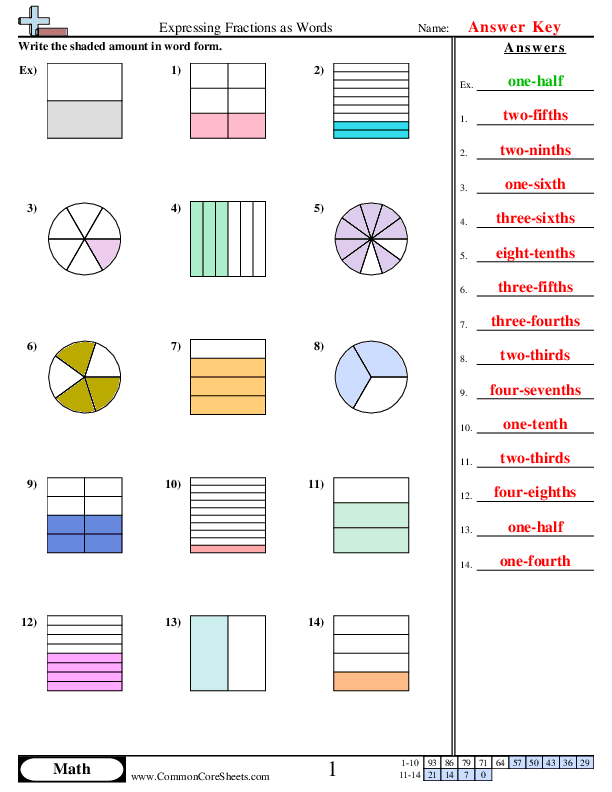
Expressing Fractions as Words


×
Description:
"This worksheet is designed to enhance children's understanding of fractions through visual representation. It features 14 math problems using interactive shapes, helping kids express fractions as words. Perfect for distance learning, the worksheet can be customized to match individual learning speeds and converted into flash cards for easy recall. A versatile tool promoting effective and fun learning of fundamental math concepts."

×
Student Goals:
Master key math skillsAfter completing this worksheet, students should have honed their critical math skills, specifically the ability to express fractions in verbal form. This skill is essential in math and can be applied in numerous real-life situations, making it an essential tool in their arsenal of mathematical knowledge.Develop problem-solving capabilitiesEach of the 14 problems presented in the worksheet are designed to challenge students and make them think. The process of solving these problems can help them develop problem-solving capabilities, which are crucial not only in math but in daily life as well.Boost confidenceSuccessfully completing the worksheet and getting the correct answers will give students a confidence boost. It shows them that they can tackle complex problems and come up with the correct answer, which can lead to increased self-confidence when they encounter similar types of problems in the future.Improve concept comprehensionUpon completing this worksheet, students should have a stronger grasp of how to express fractions as words. This includes understanding the rules and conventions that govern how fractions are verbalized, allowing them to accurately and confidently express fractions both in writing and in conversation.Enhance attention to detailThe processes involved in math require a high level of attention to detail. As students work through the problems on this worksheet, they’ll need to pay careful attention to each step to ensure they get the correct answer. This practice can help improve their overall attention to detail.Nurture perseveranceMathematics can be challenging, and it can take numerous attempts to solve a problem correctly. By working through the problems on this worksheet, students get the opportunity to nurture a sense of perseverance. They’ll learn the value of patience and persistence in finding the correct answer.Enhance mathematical fluencyThis worksheet provides students with the opportunity to enhance their mathematical fluency. By continuously practicing and mastering such key skills, they lay a firm foundation for advanced mathematical operations, opening doors to a wide range of learning possibilities in the future.















